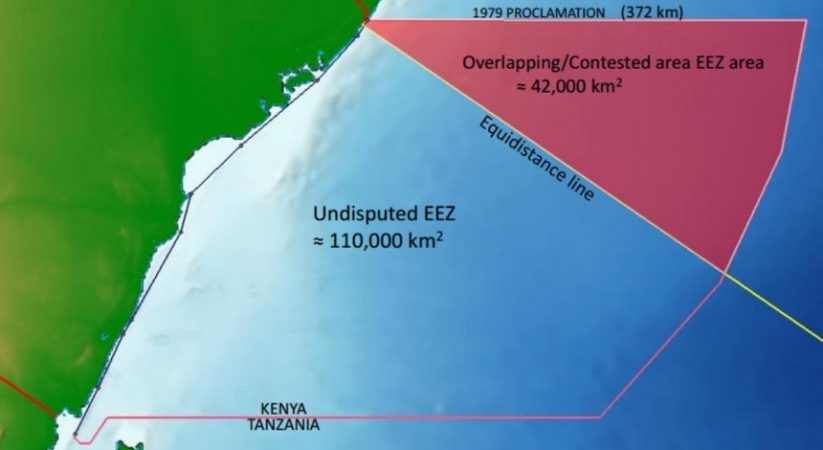
N.B.: The MoU between Kenya and Somalia cited below was drawn illegally and was signed by unauthorized officials, which is why the UN has withdrawn the fraudulent document from its depository.
Fact is that Somalia has since 1973 (Somali Law on the Sea) territorial waters of 200 nautical miles (like Peru) and since 2014 a continental shelf zone of 350 nautical miles, determined by the International Seabed Authority. In addition Somalia was one of the first signatories to UNCLOS long before Kenya – and had ratified this United Nations Common Law of the Seas – which granted Somalia an overlapping 200 miles Exclusive Economic Zone of 200 nautical miles, whose boundary to its neighbours is likewise unmistakeably delineated by UNCLOS.
Therefore the boundary between Kenya and Somalia has to follow the 90 degree line from the coastal tangent at the border. But since 1989 numerous, unsuccessful attempts (incl. by the USA, the EU and Norway, not at least Kenya) have been made to curb Somalia’s maritime estate with numerous deceiving and defective actions and false conference and media reports.
The selling of oil-exploration blocks to numerous bidders inside the illegally claimed waters by mainly Kenyan middle-men has let already to numerous Mafia-style wrangles and fraudulent share-sales for these areas.
By EMMANUEL WANJALA – TheStar – Attorney General Githu Muigai is leading the Kenyan delegation to the International Court of Justice (ICJ) in The Hague to present Kenya’s submissions to the Court on the Maritime Delimitation in the Indian Ocean.
The suit against Kenya was filed by the Federal Republic of Somalia on August 28, 2014, requesting the Court to determine the precise geographical boundary dividing all the maritime area between Kenya and Somalia in the Indian Ocean.
Kenya has however held that it has exercised uncontested jurisdiction over the disputed maritime areas since it first proclaimed its Exclusive Economic Zone (EEZ) in 1979.
Kenya further considers that the maritime boundary should follow the ‘parallel of latitude’ which has been used as the boundary between itself and Somalia since 1924.
Kenya has also challenged the jurisdiction of the ICJ to hear the matter and the admissibility of the suit by Somalia.
According to the AG’s office, an MOU between Kenya and Somalia signed on April 7, 2009 in Nairobi, the two parties agreed to delimit the maritime boundary by negotiation, and not through Court processes.
The MOU held that an agreement would be finalized only after the UN Commission on the Limits of the Continental Shelf had established the outer limits of that maritime boundary.
Kenya argues that the Court’s jurisdiction specifically excludes disputes where the parties have agreed to another method of settlement as is with the current case.
The preliminary objection forms the core of the oral proceedings to be held between Monday 19 and Friday 23 September 2016.
Somalia is represented in the suit by Paul Reichler of Foley Hoag LLP, New York and Prof. Allain Pellet, a French International Lawyer.
Kenya’s legal team comprise of Prof. Payam Akhavan (American), Prof Vaughan Lowe QC (British) and Prof Alan Boyle (British.
The others are Prof Mathias Forteau (French), Karim A. A. Khan (British) and Amy Sanders (British).
Kenya remains committed to friendly neighbourly relations and the establishment of peace and security in Somalia, and to the delimitation of the maritime boundary at the appropriate time in accordance with the agreed procedure, said a statement from the AG’s office on Saturday.
_____________________________________________________________________________________
Xafiiska Wararka Qaranimo Online | Mogadishu, Somalia
_____________________________________________________________________________________Advertisement
_____________________________________________________________________________________







